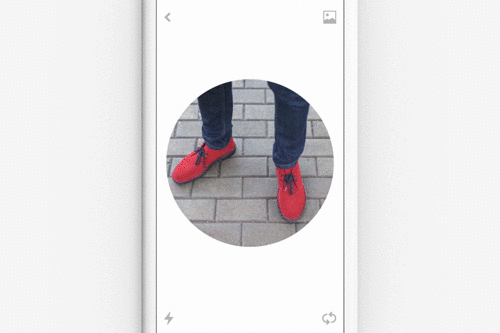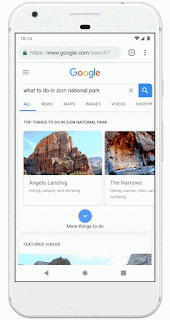Visual Search : future
Visual search can take the user experience to a completely new level: People can upload a picture to conduct an enquiry and obtain more specific results.
Visual search consists of each search that uses real-world images like photos or screenshots as a start line . Every time you point your Google Lens camera at a bit of clothing, you're performing a visible search. Whenever you employ Pinterest to try to to a method match, you're doing a visible search. Visual search answers questions like: “Show me stuff that’s kinda like that but different”, or “I don’t know what I want, but I’ll know it when I see it”.
It’s not just style matching that awesome outfit you saw or finding out what type of chair is in that hipster interior, it going much farther than that and still we’re only at the beginning. Photo apps can read text in images and translate it. Computer vision can recognize plenty of entities, from celebrities to logos and from landmarks to handwriting. At the instant , visual search is making waves within the fashion and residential decor sectors, with big brands like Amazon, Macy’s, ASOS and Wayfair leading the way.
 |
| Visual: The future is search |
Research shows consumers are very curious about using visual search as a part of their shopping experience. What’s more, a recent Sparktoro article uncovered that Google Images is that the second largest player within the program market with 21% of searches starting there. Images are here to stay.
Currently, the main target is on making sense of images and doing something useful with it. Soon, we’ll also see visual search come into contact with augmented reality and maybe even virtual reality? While AR and VR have been hyped to death by now, the killer application of these technological developments still has to be found. Maybe augmenting the real-world onto visual search results could be just that?
Visual search are often used for tons of things, like helping you discover landmarks during a strange city, helping you increase productivity or find the gorgeous pair of shoes that fits perfectly with that new dress you bought. It can also help you identify stuff like plants and animals and teach you how to do a particular chore. Who knows what else?
It has a number of applications within the eCommerce industry, particularly for fashion and residential decor retailers. Visual search allows retailers to suggest thematically or stylistically related items to shoppers during a way they might struggle to try to to employing a text query alone.
Pinterest, Google, and Amazon are the most visual search engines today. Microsoft has also developed impressive computer vision capabilities for its Bing program .
A) Pinterest Lens
Not surprisingly, Pinterest has jumped on the visual search bandwagon. They came out with Lens, a visual search tool that allows users to take a photo of an item to find out where to buy it online, search for similar products or view pinboards of related items.
As Marketing Land puts it, it turns your phone’s camera into a search bar:

Since the launch of the beta version, Pinterest's Lens now recognizes 2.5 billion home and fashion objects, has inspired over 600 million searches on Pinterest’s mobile apps and browser extensions, and has seen a 140% uptick from launch day.
Pinterest has continued to update its functionality:
They introduced Pincodes, a QR code-type technology that enables you to find inspiration while you're out shopping or flipping through your favorite magazines.
They launched Lens Your Look to take the guesswork out of outfit planning.
They partnered with brands like Samsung to bring visual search to its latest smartphones and Target to allow customers to search their catalog using related products they see in the real world.
They've fully automated Shop the design , a feature that helps users buy products from companies that employment with Pinterest, so you'll , for instance , buy a pair of jeans you see in a picture.
They launched a bunch of new tools to help merchants sell their products, including Catalogs, which lets anyone upload and convert their entire product catalog into shoppable Pins.
Make sure you're optimizing for visual search, because (not surprisingly) the highest search categories for Lens are:
- Fashion
- Home decor
- Art
- Food
- Products
- Animals
- Outfits
- Beauty
- Vehicles
- Travel
B) Google Lens
And Pinterest isn't the sole one with visual search. Google Lens may be a visual program by Google, which recognizes objects and landmarks through a camera app. Here's what you can do when you take a photo of the following items:

Apparel and residential goods: Find similar products and where to shop for them.
Barcodes: Use a barcode to find info about a product, like where to buy it.
Business card: Save the telephone number or address to a contact.
Book: Get a summary and read reviews.
Event flyer or billboard: Add the event to your calendar.
Landmark or building: See historical facts, hours of operation, and more.
Painting during a museum: examine the artist and learn more.
Plant or animal: Learn about species and breeds.
As CNet says, “Google Lens is turning into what Google Glass never was” when it comes to real-time augmented reality.
C) CamFind
CamFind is another visual search mobile app which enables you to look for love or money from your phone just by snapping an image .
Instead of typing queries into an enquiry engine, you'll directly search via images to seek out similar images, price comparisons, local shopping results, etc. You can also take an image of a movie poster and CamFind will show you movie information, trailers, showtimes and native theaters.
And with
D)Bing
Bing Visual Search, you'll look for a selected element within a picture without having to travel through all the present hoops.
Bing is extremely active within the visual search space. Microsoft has been doing a lot of research and making lots of knowledge freely available. Not only do they have integrated their visual search in a really cool mobile app for the large platforms, but they also have a dedicated web platform. This website demonstrates the facility of Bing visual search and it works alright . Just upload a picture and see what Bing makes of it. Or use one of the example images to get a quick idea of how good it works.
Developers can harness the facility of visual search to append a skill to a matched image. So, if you've got a lot of products that Bing recognizes, ready to you'll define what a searcher should be able to do once your image has been analyzed. For this, the visual search identifies the intent of the search and requests different skills supported that intent. After that, Bing combines the talents and sends them to the app. If you've got a home decor store, an enquiry like this won't only yield a buy skill, but also a DIY skill. You can build these skills yourself. Try it on the Bing Visual Search Development Platform.

For example, say you’re looking for kitchen decoration inspiration and an image attracts your attention. You click on a thumbnail result to urge to the “Detail View.” the general décor is great, but you’re particularly curious about that nice-looking chandelier. Wouldn’t you love to know where you can get one just like it? With Bing Visual Search, now you can.
As per Social Media Today:
63% of Millennials are more curious about visual search capabilities than the other new technology
Images are returned for 21% of search queries on Google
There are over 601 million visual searches on Pinterest monthly
Marketers can get the sting on competitors by jumping on the visual search trend in 2020 to draw customers and serve them the right product.
Visual Search Trends
Integration with chatbots: Visual search starts a conversation; a fact some retailers are exploiting to integrate a chatbot into the shopping experience. Inc
Big retailers are on board: Target has been using Pinterest Lens for the past year. WSJ
Pinterest is combining visual search with text search, which should increase its reach.
Visual platforms like Instagram and Snapchat have a natural tie-in with visual search, if they will make the shopping experience as frictionless as possible.
Brands (notably, Mastercard) are dropping text from their images altogether in favor of a design-driven expression of their identity.
Google Search offers an increasingly visual experience, both through the presence of more images and also within the redesigned interface . Basically, Google Images looks more and more like Pinterest.
Retailers are developing their own visual search capabilities, rather than relying on search engines and social networks to act as the intermediary.





